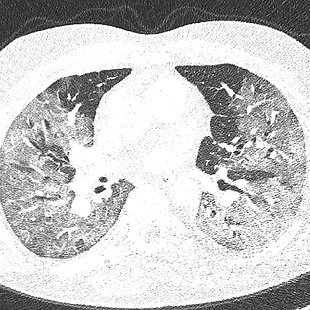Pacient s COVID-19 v nemocniční péči
COVID-19 je v současné době celosvětovým problémem. Pacienti vyžadují specifickou péči již během prvotního zajištění na odděleních urgentního příjmu. Celá řada pacientů je pro rozsáhlou virovou pneumonii od přijetí dependentních na vysokoprůtokové oxygenoterapii a vyžaduje hospitalizaci na lůžku jednotky intenzívní péče. U části z nich dochází i přes veškerou léčbu k progresi plicního postižení až do formy syndromu akutní respirační dechové tísně s nutností analgosedace, tracheální intubace a napojení na umělou plicní ventilaci. Adekvátní výměny krevních plynů pak nelze často dosáhnout při nastavení protektivní formy umělé ventilace. A proto se musí lékař uchýlit k použití pronační polohy a v nejtěžších případech také k metodám extrakorporální oxygenace. Tento algoritmus je rozdělen do dvou částí a řešitel se může hned v úvodu rozhodnout, zda se chce věnovat péči o nemocného s COVID-19 na urgentním příjmu nebo sehrát roli intenzivisty.
Recenze
Onemocnění způsobené SARS-CoV-2 (COVID-19) je vysoce aktuální problematikou, pandemického charakteru, která vede celosvětově k velké zátěži pro zdravotní systém, a u těžkých forem i k významnému nárůstu morbidity a mortality. Syndrom akutní dechové tísně (ARDS) na podkladě COVID-19 obvykle vede k život ohrožující poruše výměny respiračních plynů, která nelze řešit pomocí protektivního nastavení konvenční umělé plicní ventilace či pronační polohou, a je nutno uvažovat o zahájení podpory metodou extrakorporální membránové oxygenace (ECMO). Zvládnutí péče o pacienty s COVID-19 při jejich příchodu do nemocnice, např. přes urgentní příjem (UP), potažmo hospitalizace na jednotce intenzívní péče (JIP), je tedy aktuálně stěžejní součástí pracovní náplně mnoha zdravotnických pracovníků nejen v ČR. Prezentovaný algoritmus je přehledným návodem, jak vést management COVID-19 pacientů ve dvou stupních závažnosti, kdy ve dvou větvích logicky popisuje zdravotní péči od UP až po JIP.
Zdroje
ALHAZZANI, Waleed, et al. Surviving Sepsis Campaign Guidelines on the management of adults with coronavirus disease 2019 (COVID-19) in the ICU: first update. Critical care medicine, 2021, 49.3: e219-e234. [online]. [cit. 2021-04-04]. Dostupné z: https://journals.lww.com/ccmjournal/pages/articleviewer.aspx?year=2021&issue=03000&article=00021&type=Fulltext
FLAJŠINGROVÁ J., et al. Příjem a třídění pacientů se suspektním nebo potvrzeným COVID-19. [online]. [cit. 2021-04-01]. Dostupné z: https://csim.cz/wp-content/uploads/07_DP_SUMMK_CSARIM_CSIM_Prijem-a-triage-pacienta-s-COVID-19-na-UP_verze_070420_final.pdf
CAPUTO, Nicholas D., Reuben J. STRAYER a Richard LEVITAN. Early Self‐Proning in Awake, Non‐intubated Patients in the Emergency Department: A Single ED’s Experience During the COVID‐19 Pandemic. Academic Emergency Medicine [online]. 2020, roč. 27, č. 5, s. 375–378. ISSN 1069-6563. [online]. [cit. 2021-04-01]. Dostupné z: https://pubmed.ncbi.nlm.nih.gov/32320506/
BALÍK, M., et al. Použití kortikosteroidů u COVID-19. [online]. [cit. 2021-04-01]. Dostupné z: https://csim.cz/wp-content/uploads/Kortikosteroidy-u-Covid-19_5.10.2020.pdf
JUMA, Salina; TAABAZUING, Mary-Margaret; MONTERO-ODASSO, Manuel. Clinical frailty scale in an acute medicine unit: a simple tool that predicts length of stay. Canadian Geriatrics Journal, 2016, 19.2: 34. [online]. [cit. 2021-04-04]. Dostupné z: https://www.ncbi.nlm.nih.gov/pmc/articles/PMC4922366/
ZUCMAN, Noémie, et al. Prediction of outcome of nasal high flow use during COVID-19-related acute hypoxemic respiratory failure. Intensive care medicine, 2020, 46.10: 1924-1926. [online]. [cit. 2021-04-01]. Dostupné z: https://link.springer.com/article/10.1007%2Fs00134-020-06177-1
COOK, T. M., et al. Consensus guidelines for managing the airway in patients with COVID‐19: Guidelines from the Difficult Airway Society, the Association of Anaesthetists the Intensive Care Society, the Faculty of Intensive Care Medicine and the Royal College of Anaesthetists. Anaesthesia, 2020, 75.6: 785-799. [online]. [cit. 2021-04-01]. Dostupné z: https://doi.org/10.1111/anae.15054
NATIONAL HEART, LUNG, AND BLOOD INSTITUTE ARDS CLINICAL TRIALS NETWORK. Higher versus lower positive end-expiratory pressures in patients with the acute respiratory distress syndrome. New England Journal of Medicine, 2004, 351.4: 327-336. [online]. [cit. 2021-04-01]. Dostupné z: https://www.nejm.org/doi/full/10.1056/NEJMoa032193
NATIONAL HEART, LUNG, AND BLOOD INSTITUTE ARDS CLINICAL TRIALS NETWORK. Ventilator protocol card. [online]. [cit. 2021-04-01]. Dostupné z: http://www.ardsnet.org/files/ventilator_protocol_2008-07.pdf Doporučený postup „COVID-19“ ČSARIM a ČSIM - Ventilační podpora u pacientů s COVID-19. 2020. Dostupný z: https://csim.cz/wp-content/uploads/06_DP_COVID_CSARIM_UPV_verze_1_050420_final.pdf
FERRANDO, Carlos, et al. Clinical features, ventilatory management, and outcome of ARDS caused by COVID-19 are similar to other causes of ARDS. Intensive care medicine, 2020, 46.12: 2200-2211. [online]. [cit. 2021-04-01]. Dostupné z: https://link.springer.com/article/10.1007/s00134-020-06192-2 GUÉRIN, Claude, et al. Prone positioning in severe acute respiratory distress syndrome. New England Journal of Medicine, 2013, 368.23: 2159-2168. [online]. [cit. 2021-04-01]. Dostupné z: https://www.nejm.org/doi/full/10.1056/nejmoa1214103
MÁCA, Jan. ARDS v klinické praxi. Maxdorf Jessenius, 2019.
Life In The Fastlane. https://litfl.com/coronavirus-disease-2019-covid-19/





